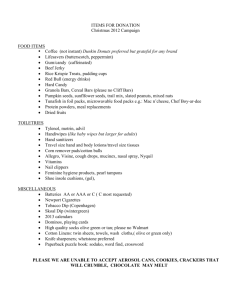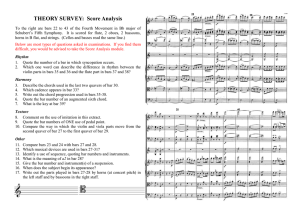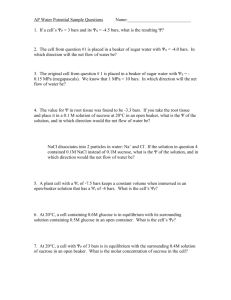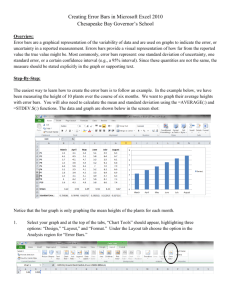Change the display of error bars
advertisement
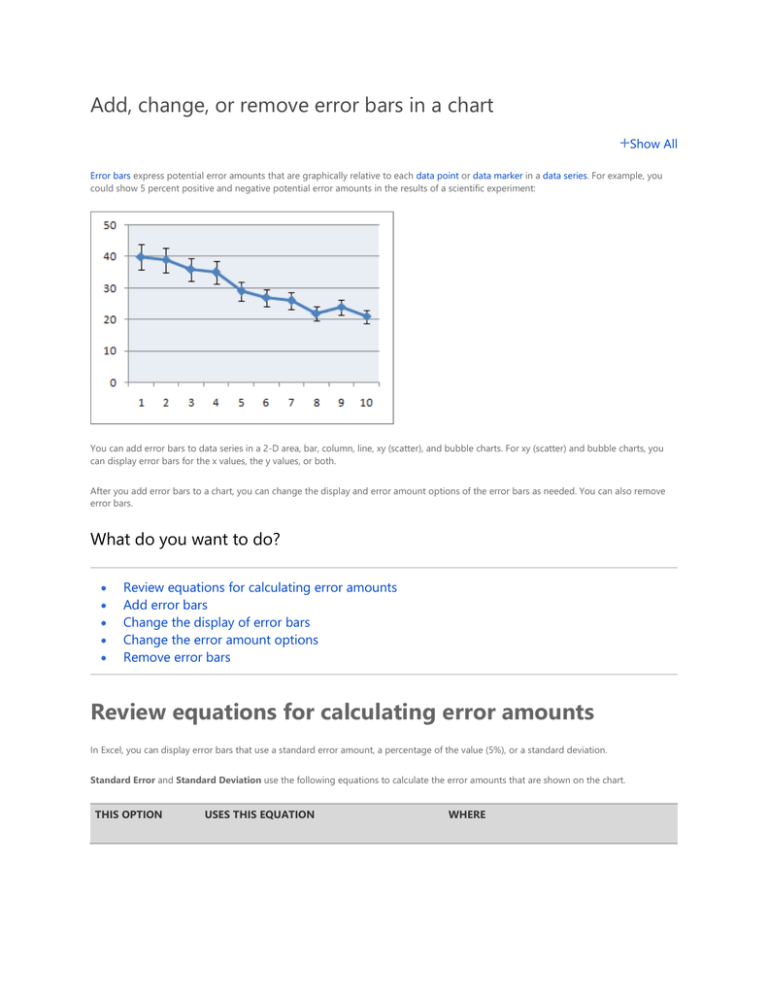
Add, change, or remove error bars in a chart Show All Error bars express potential error amounts that are graphically relative to each data point or data marker in a data series. For example, you could show 5 percent positive and negative potential error amounts in the results of a scientific experiment: You can add error bars to data series in a 2-D area, bar, column, line, xy (scatter), and bubble charts. For xy (scatter) and bubble charts, you can display error bars for the x values, the y values, or both. After you add error bars to a chart, you can change the display and error amount options of the error bars as needed. You can also remove error bars. What do you want to do? Review equations for calculating error amounts Add error bars Change the display of error bars Change the error amount options Remove error bars Review equations for calculating error amounts In Excel, you can display error bars that use a standard error amount, a percentage of the value (5%), or a standard deviation. Standard Error and Standard Deviation use the following equations to calculate the error amounts that are shown on the chart. THIS OPTION USES THIS EQUATION WHERE Standard Error s = series number i = point number in series s m = number of series for point y in chart n = number of points in each series yis = data value of series s and the ith point ny = total number of data values in all series Standard Deviation s = series number i = point number in series s m = number of series for point y in chart n = number of points in each series yis = data value of series s and the ith point ny = total number of data values in all series M = arithmetic mean Top of Page Add error bars 1. On 2-D area, bar, column, line, xy (scatter), or bubble chart, do one of the following: 1. To add error bars to all data series in the chart, click the chart area. To add error bars to a selected data point or data series, click the data point or data series that you want, or do the following to select it from a list of chart elements: Click anywhere in the chart. This displays the Chart Tools, adding the Design, Layout, and Format tabs. 2. On the Format tab, in the Current Selection group, click the arrow next to the Chart Elements box, and then click the chart element that you want. 1. On the Layout tab, in the Analysis group, click Error Bars. 2. Do one of the following: Click a predefined error bar option, such as Error Bars with Standard Error, Error Bars with Percentage, or Error Bars with Standard Deviation. Click More Error Bar Options, and then under Vertical Error Bars or Horizontal Error Bars, click the display and error amount options that you want to use. NOTE The direction of the error bars depends on the chart type of your chart. For scatter charts, both horizontal and vertical error bars are displayed by default. You can remove either of these error bars by selecting them, and then pressing DELETE. Top of Page Change the display of error bars 1. On a 2-D area, bar, column, line, xy (scatter), or bubble chart, click the error bars, the data point, or the data series that has the error bars that you want to change, or do the following to select them from a list of chart elements: 1. Click anywhere in the chart. This displays the Chart Tools, adding the Design, Layout, and Format tabs. 2. On the Format tab, in the Current Selection group, click the arrow next to the Chart Elements box, and then click the chart element that you want. 2. On the Layout tab, in the Analysis group, click Error Bars, and then click More Error Bar Options. 3. Under Display, click the error bar direction and end style that you want to use. Top of Page Change the error amount options 1. On a 2-D area, bar, column, line, xy (scatter), or bubble chart, click the error bars, the data point, or the data series that has the error bars that you want to change, or do the following to select them from a list of chart elements: 1. Click anywhere in the chart. This displays the Chart Tools, adding the Design, Layout, and Format tabs. 2. On the Format tab, in the Current Selection group, click the arrow next to the Chart Elements box, and then click the chart element that you want. 2. On the Layout tab, in the Analysis group, click Error Bars, and then click More Error Bar Options. 3. Under Error Amount, do one or more of the following: To use a different method to determine the error amount, click the method that you want to use, and then specify the error amount. To use custom values to determine the error amount, click Custom, and then do the following: 1. Click Specify Value. 2. In the Positive Error Value and Negative Error Value boxes, specify the worksheet range that you want to use as error amount values, or type the values that you want to use, separated by commas. For example, type 0.4, 0.3, 0.8. TIP To specify the worksheet range, you can click the Collapse Dialog button , and then select the data that you want to use in the worksheet. Click the Collapse Dialog button again to return to the dialog box. NOTE In Microsoft Office Word 2007 or Microsoft Office PowerPoint 2007, the Custom Error Bars dialog box may not show the Collapse Dialog button, and you can only type the error amount values that you want to use. Top of Page Remove error bars 1. On a 2-D area, bar, column, line, xy (scatter), or bubble chart, click the error bars, the data point, or the data series that has the error bars that you want to remove, or do the following to select them from a list of chart elements: 1. Click anywhere in the chart. This displays the Chart Tools, adding the Design, Layout, and Format tabs. 2. 2. On the Format tab, in the Current Selection group, click the arrow next to the Chart Elements box, and then click the chart element that you want. Do one of the following: On the Layout tab, in the Analysis group, click Error Bars, and then click None. Press DELETE. TIP You can remove error bars immediately after you add them to the chart by clicking Undo on the Quick Access Toolbar or by pressing CTRL+Z.

